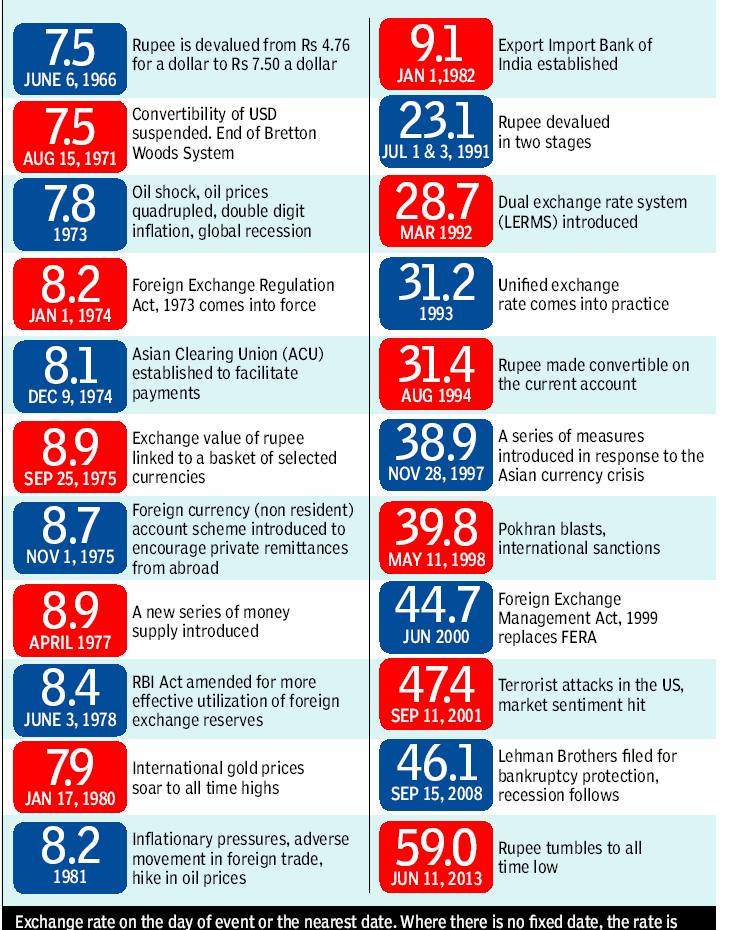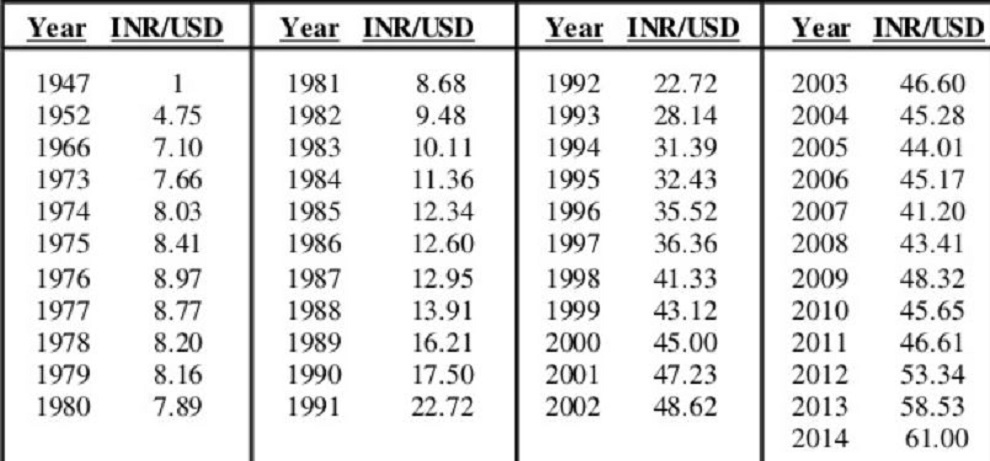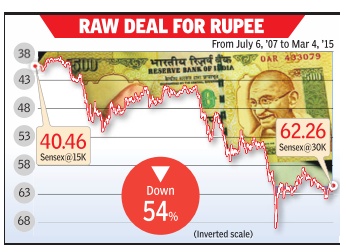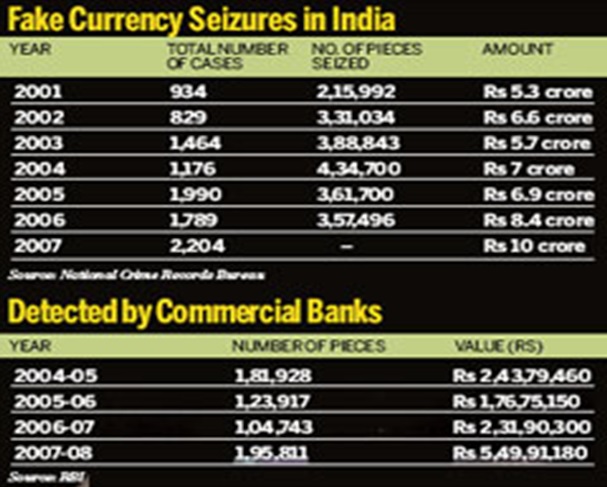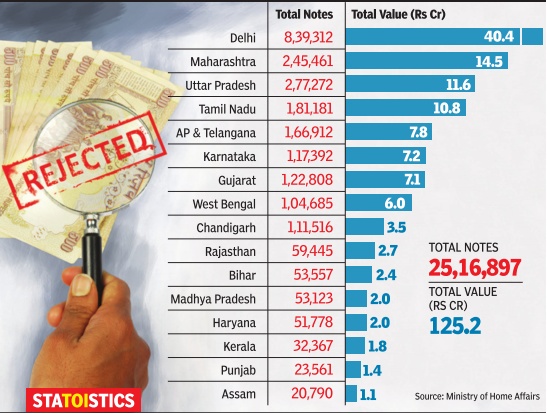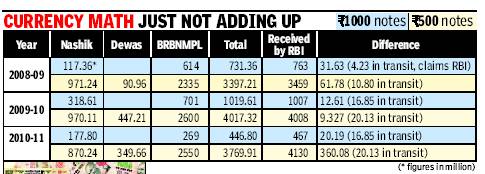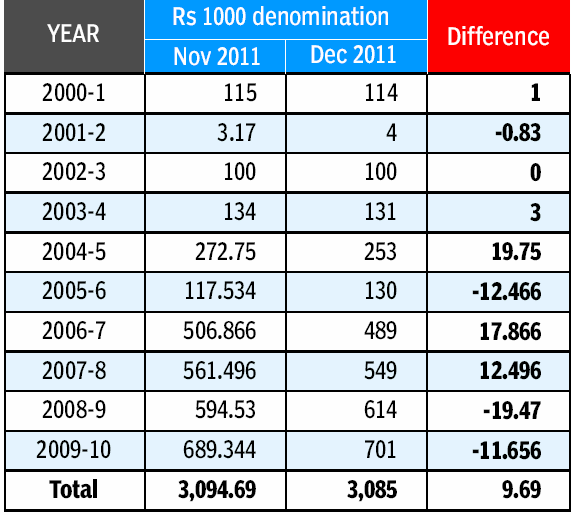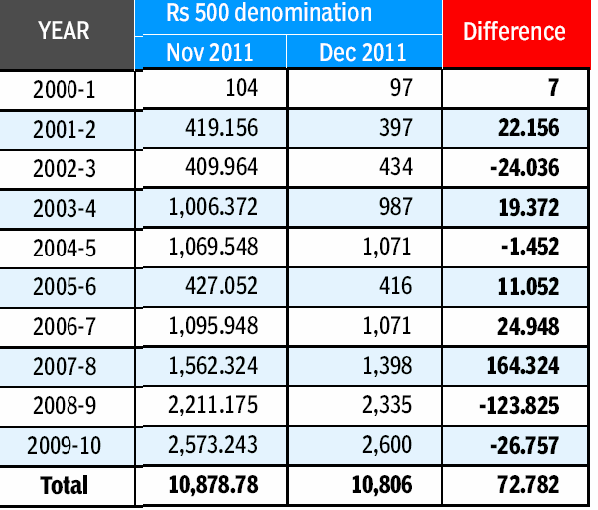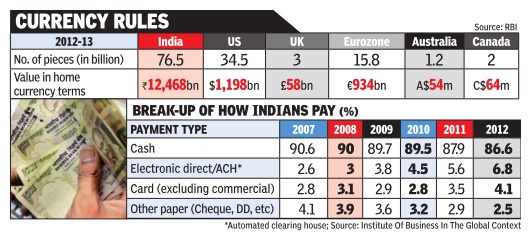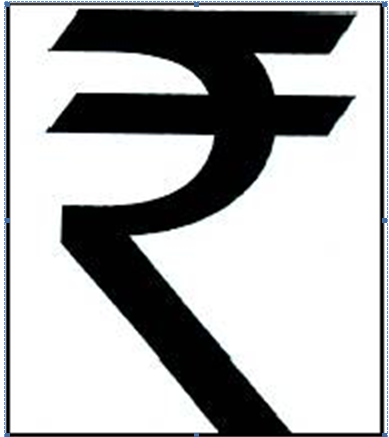Currency: India
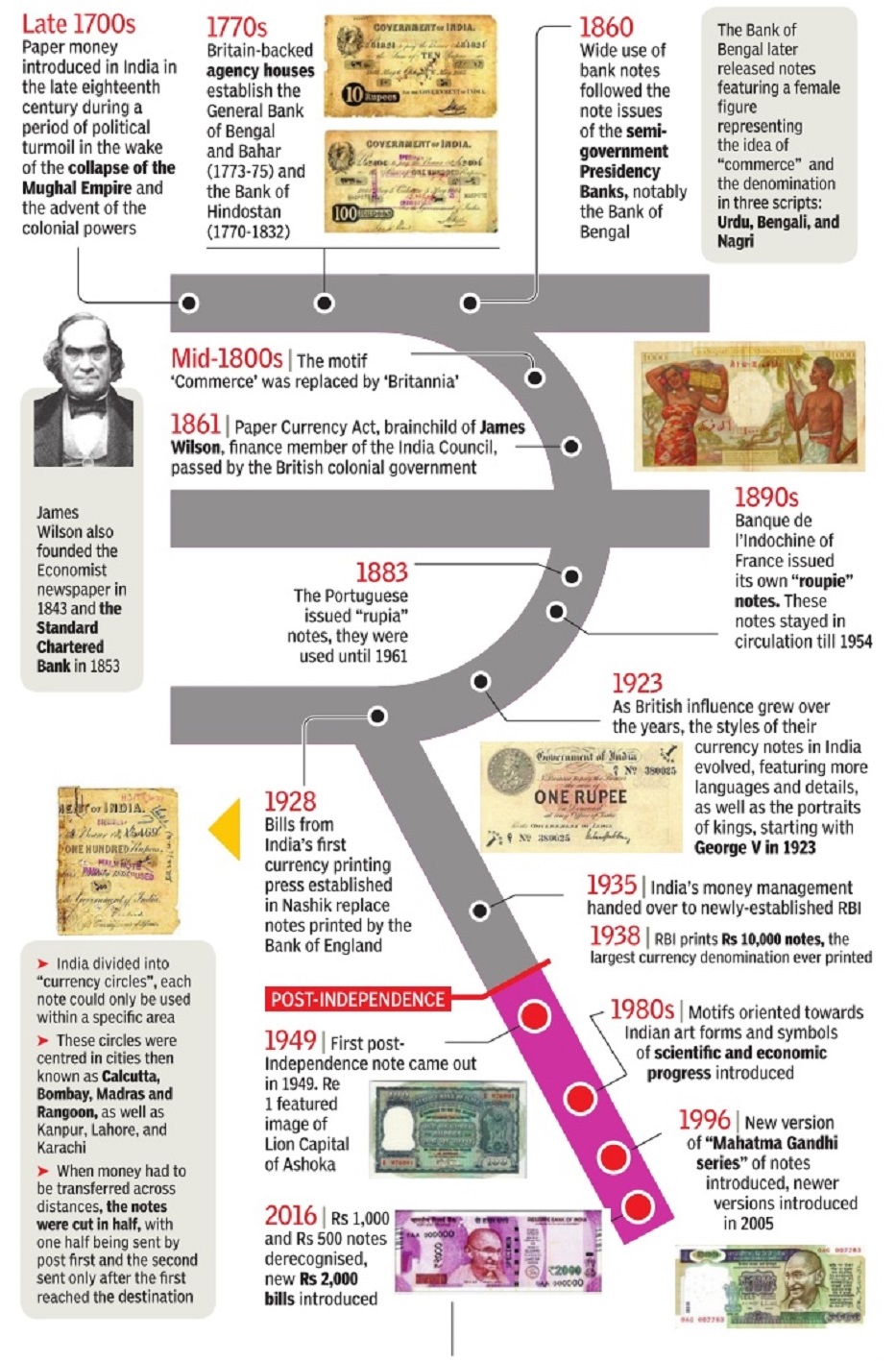
The Times of India
This is a collection of articles archived for the excellence of their content. |
History
A history of paper currency in India, 1720-2016 (chart)
See the large The Times of India graphic on this page.
A history of paper currency in India (text)
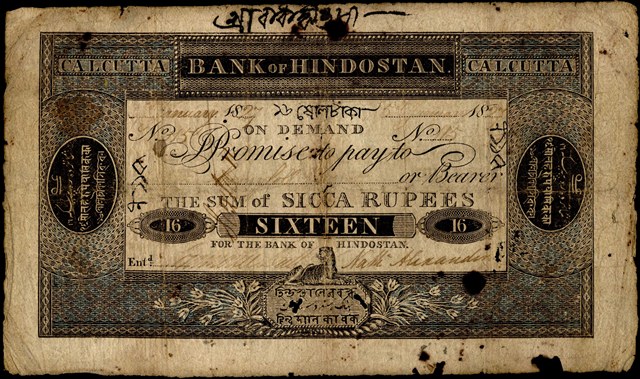
Rezwan Razack/ Indian Bank Note
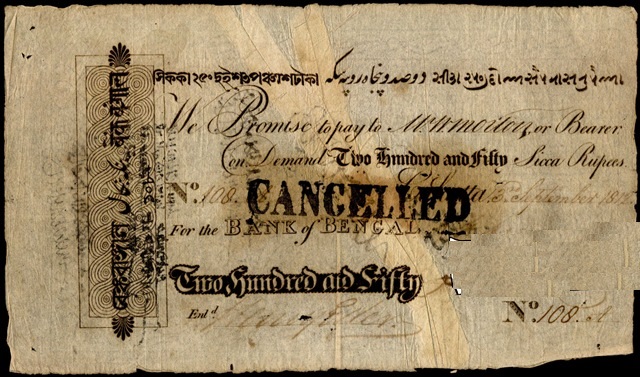
Rezwan Razack/ Indian Bank Note
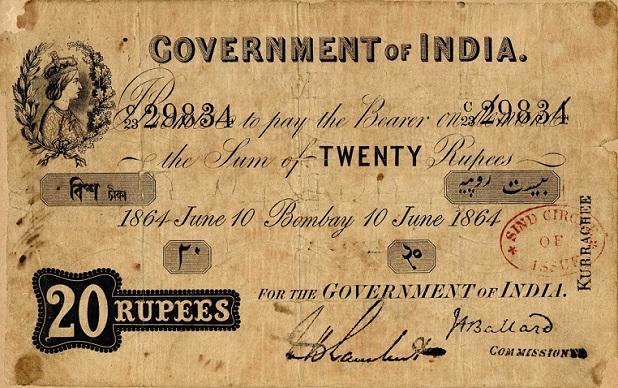
Rezwan Razack/ Indian Bank Note
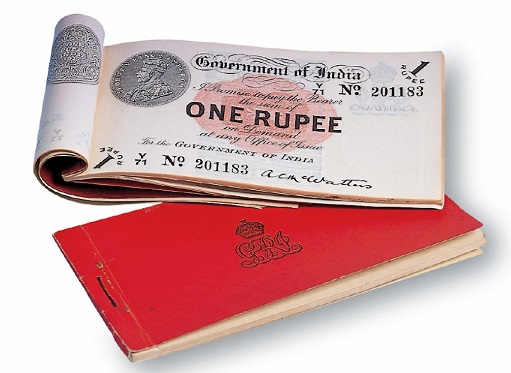
Rezwan Razack/ Indian Bank Note
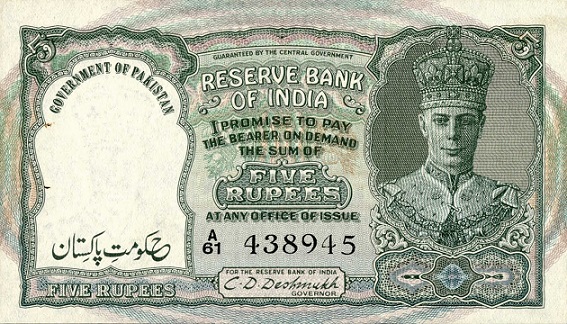
Rezwan Razack/ Indian Bank Note
Some additional facts
i) Mainly from Rezwan Razack/ Indian Bank Note, author of The Revised Standard Reference Guide to Indian Paper Money.
ii) And also from The Hindu Businessline and
iii) India Today, May 4, 2016
Indian currency is as historic as the Indian civilization. Currency in the form of punch-marked coins existed even before Christ. Coinage can be traced back to as early as the 6th century BC, in the earliest of civilizations in India. This history of coins and notes is as interesting as it is long.
Currency has existed in the form of coinage in India since the 6th century BC. The Ancient, the medieval and the Mughal period all used currency in the form of coinage. The most notable was Sher Shah Suri's Rupiya, which became the precursor of the modern rupee.
Paper money was first issued in the late eighteenth century. Bank of Hindostan, General Bank in Bengal and the Bengal Bank are the first banks to have issued paper currency.
The first Indian banknotes were issued by the Bank of Hindostan, a private bank, in 1770. The notes ranged from Rs.10 to Rs10,000. (See picture on this page.)
Denominations in those days included Rs.4, Rs,15, Rs.16 and Rs.250 sicca.
It was only in 1861 that the Government of India took over the issue of banknotes from private (eg Bank of Hindostan) and Presidency (e.g. the Madras Government Bank) banks. (See ‘uniface’ picture on this page.)
Government of India's first set of notes was the Victoria portrait series. For security reasons, the notes of this series were cut in half; one half was sent by post, and upon confirmation of receipt, the other half was sent. They were replaced by the Underprint series in 1867.
A Rs.2.50 (Two Rupees and Eight Annas) note was issued in 1918.
The first Re.1 notes were issued in 1917, with a portrait of King George V. Mr. Razack writes, ‘25% of these Rupee One notes were issued in a booklet of 25 notes.’ (See picture on this page.)
In 1935 The Reserve Bank of India was created. Ever since then it has been the only authority that can issue Government of India currency notes. The first note issued by the RBI was a five rupee note bearing King George VI's portrait.
The highest denomination note ever printed by the Reserve Bank of India was the Rs. 10,000 note in 1938 and again in 1954. But these notes were demonetised in January 1946. Rs. 1,000 and Rs. 10,000 bank notes were in circulation prior to January 1946. Higher denomination banknotes of Rs. 1,000, Rs. 5,000 and Rs. 10,000 were reintroduced in 1954 and all of them were demonetised in January 1978.
The one rupee note was the first banknote printed by independent India.
Immediately after the partition of India on 14 August 1947, Indian rupees were legal tender in Pakistan. In the later part of 1947, till some time in 1948, Pakistani rupees were essentially Indian rupees printed by the Reserve Bank of India, with the words ‘Government of Pakistan’ and ‘Hukumat e Pakistan’ printed in the window on the left. (See picture on this page.)
‘Notes of all denominations issued by the Reserve Bank of India after independence have the Ashoka Pillar and the Seal of Reserve Bank of India,’ Mr. Rezwan Razack informs us. Bank notes in Ashoka Pillar watermark series in Rs. 10 denomination were issued between 1967 and 1992, Rs. 20 in 1972 and 1975, Rs. 50 in 1975 and 1981 and Rs. 100 between 1967-1979. The banknotes issued during this period contained the symbols representing science and technology, progress and orientation to Indian art forms.
In the year 1980, the legend Satyameva Jayate - ‘truth alone shall prevail’ - was incorporated under the national emblem for the first time.
Re.100 notes were India’s highest denomination notes from 1978 to 1987.
Re.500 notes made a comeback on 23 October 1987, with a Braille feature on them, and later on most other notes.
Re.1,000 notes came back in November 2000. The move was then justified as attempt to contain the volume of banknotes in circulation due to inflation.
Nov 2016 was the first time that the Rs. 2,000 currency note was introduced.
Mr. Rezwan Razack also informs us that:
i) Star or Replacement notes were issued from 2006 onwards.
ii) The year of issue started being printed on the reverse of the notes from 2005 onwards.
iii) The only Governors of the Reserve Bank of India who did not sign a note were Mr. Osborne Smith and Mr. Ambegaonkar. However, Mr. Ambegaonkar signed the Re.1 note as the Secretary, Ministry of Finance, Government of India.
iv) There is only one instance of Republic of India notes being printed by the American Banknote Company, U.S.A., and that in 1997-98.
v) Notes of the ‘Government of India’ and ‘The Reserve Bank of India’ were issued for use in the Trucial and Gulf States of Kuwait, Bahrain, Qatar, Muscat and Oman from 1959-1966. They looked exactly like the notes used in India in those days but were printed in a different colour.
vi) A special batch of Re.10 and Re.100 notes was printed and issued in 1959 for Indian Haj Pilgrims for exchange with the local currency in Saudi Arabia. They had the word ‘HAJ’ printed discreetly in t Roman script on either side of the words ‘Reserve Bank.’ But otherwise they looked like normal Indian notes.
Mahatma Gandhi
In October 1987, Rs. 500 banknote was introduced with the portrait of Mahatma Gandhi and Ashoka Pillar watermark.
Mahatma Gandhi (MG) series banknotes — 1996 were issued in the denominations of Rs. 5, (introduced in November 2001), Rs. 10 (June 1996), Rs. 20 (August 2001), Rs. 50 (March 1997), Rs. 100 (June 1996), Rs. 500 (October 1997) and Rs. 1,000 (November 2000).
The Mahatma Gandhi Series - 2005 bank notes were issued in the denomination of Rs. 10, Rs. 20, Rs. 50, Rs. 100, Rs. 500 and Rs. 1,000 and contained some additional/new security features as compared to the 1996 MG series.
The Rs. 50 and Rs. 100 banknotes were issued in August 2005, followed by Rs. 500 and Rs. 1,000 denominations in October 2005 and Rs. 10 and Rs. 20 in April 2006 and August 2006, respectively
Coins
Denominations of 1 paise, 2 paise, 3 paise, 5 paise, 10 paise, 20 paise and 25 paise were in circulation till June 30, 2011 but were then withdrawn.
50 paise coins were in circulation even in 2016. They are called small coins while the other denominations are known as rupee coins.
The value of the rupee: fall, fall and occasional rise
1927 to 1966
From 1927 to 1966, Rs. 13 rupees = £1 (pound). Till then the rupee was pegged to the British pound sterling.
In 1966, the rupee was devalued and pegged to the U.S. dollar at a rate of Rs.7.5 = $1.
The fallacy of 'dollar = rupee' in 1947 SAURABH CHANDRA | Mon, 19 Aug 2013, DNA India adds:
Indian rupee was pegged to the British Pound till [1966] when it was devalued and pegged to the US Dollar. A good account of the two devaluations of 1966 and 1991 is given in a paper by Johri and Miller. The peg to the pound was at INR 13.33 to a Pound which itself was pegged to $4.03. That means officially speaking the USD to INR rate would be closer to Rs 4 [in 1947]. In 1966, India changed the peg to dollar at INR 7.50. Surely, the exchange rates are not very meaningful when the currencies are fixed by governments and the unofficial rates would be usually even worse given the pressure British Pound was under post world war II.
The steady depreciation of the rupee, 1966-2013
See the accompanying chart
The Times of India 15 June 2013
See Table 1
6/6/66: Devaluation of the rupee
The Times of India, June 7, 2016
June 6, 1966 - or 6/6/66 - turned out to be a defining day in independent India's economic history. It was the day on which Indira Gandhi devalued the rupee by 36.5%, increasing the dollar's value against it by 57.4%. The move sparked bitter, nationwide criticism. In both politics and economics, 1966 was India's annus horribilis. On January 11, Prime Minister Lal Bahadur Shastri - a popular, respected figure - died of a heart attack at Tashkent, and was replaced by Indira. Apparently, the Congress party old guard had conspired to install an inexperienced person, so they could call the shots.
Indira's inheritance in 1966 was onerous. Drought had ravaged foodgrain crops, forcing India to import rice and wheat for the first time. This was easier said than done, for India's foreign exchange reserves were sparse. In 1965, with imports of Rs 2,194 crore and exports of only Rs 1,264 crore, India's trade deficit of Rs 930 crore was the highest during the sixties.
With no money to import food, India sought aid from the US' ('friendly foreign government' - is this really necessary), whose 'Food for Peace' programme - authorized by Public Law 480 (PL-480) - allowed poor nations like India to pay the US in their own currency. President Lyndon B Johnson obliged by shipping 16 million tonnes of wheat, and 1 million tonnes of rice to India, and disbursing approximately $1 billion to alleviate her financial strain. Indira Gandhi's decision to accept this "ship-to-mouth" aid was unpopular.
1993-2013: Movements of the rupee
Inflation, trade imbalance sink Re
Mayur Shetty The Times of India Mar 05 2015
Growth Story Buoys Sensex Even As Currency Slips From Crisis To Crisis Historically the rupee has moved in tandem with the sensex. A surge in the equity index usually led to the domestic currency firming up against the dollar as foreign funds that drive up stocks also provide support to the rupee. Yet, despite foreign investment consistently rising, the rupee has sharply depreciated from its opening level of 32 against the dollar in 1993 -the year when it was allowed to float freely in terms of demand and supply . The answer to this behavior lies in India's higher inflation and trade deficit which has resulted in rupee finding a new floor every time there is a major global crisis.Here are some of them: Mexican crisis (August-December 1995): Triggered by risk averseness among global investors after Mexico's currency collapse, the rupee which was at 31.40 against the dollar in July `95 depreciated to 33.96 by end-September 1995 and further to 36.48 by end-January 1996. Although the fall was only five rupees it was sharp in percentage terms.Asian Currency Crisis (August '97-April '98): Much as Indian companies, banks and brokers tried to convince international investors that India was not a part of South East Asia, foreign institutional investors continued to stampede out of the country . The international sanctions after the nuclear tests known as Pokhran II did not help. Te rupee exchange rate which was 35.92 in August `'97 worsened to 42.76 against the dollar in August'98.Dotcom bust and 911 attacks (2000-2001): India saw a surge in technology stocks due to the increased business arising out of Y2K. While the dotcom bust weakened the rupee in 2000, the `risk-off' situation following the 911 attacks in New York sent the rupee into a free fall. It weakened from 43.64 per US dollar during April 2000 to 48.43 on September 17.Lehman Brothers collapse and Global Financial Crisis (2008): The rupee witnessed its longest steady spell in the run up to the global financial crisis and was trading around Rs 48 levels. After the crisis the currency breached the level of Rs.50 per dollar on October 27, 2008. The fall would have been sharper had the RBI not spent $18.7 billion worth dollars to support the rupee.US Sovereign downgrade (August 2011): In August 2011 S&P downgraded the US following a political deadlock which blocked funds to the government. But instead of the dollar weakening it was the rupee which lost as global investors sought refuge in US treasury bills.Grexit & Eurozone crises (2011-12): Portugal, Ireland, Greece and Spain formed the PIGS whose governments found it difficult to meet their debt obligations. Greece came close to defaulting and exiting the European Union. The resultant volatility saw the rupee weaken to 54.24 against the dollar during this period but regained its losses the next year.US Taper Tantrums: In May 2013 chief of US Fed Ben Bernanke said that he was considering tapering back the Fed's $70 billion a month liquidity infusion through buyback of bond and mortgage backed securities. When the US Fed sneezes, world markets catch a cold. The rupee fell the sharpest among emerging economies due to India's gigantic current account deficit. Between May 22, 2013 & August 30, 2013, the currency fell 15.5% against the US Dollar.
Depreciation: 2000-13
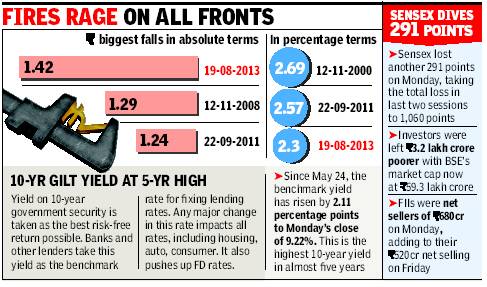
2013: Stabilising the Re through FCNR
The Times of India, Aug 13 2016
Rajan found scheme that rescued Re in 2013 `idiotic'
Outgoing RBI governor Raghuram Rajan said on Friday that he found the $34-billion foreign currency deposit scheme, which staved off a collapse of the rupee in September 2013, to be “completely idiotic“ and “worst of the ideas on the table“ when it was first proposed, but it worked. The RBI's success in taming the runaway rupee in September in 2013 was seen as Rajan's big achievement in his initial months. A special foreign currency non-resident (FCNR-B) deposit scheme, which garnered $34 billion, was seen to have played a crucial role in stabilizing the currency . The scheme was among the first announcements made by Rajan after taking charge.
Speaking during a discussion on former governor D Subbarao's book, `Who Moved My Interest Rate', Rajan said: “I get credit for that idea which I neither invented nor believed in.“
He said that upon joining as an understudy in August, he went around seeking suggestions on what new and interesting measures the RBI could take to change the narrative on the rupee. “There was one proposal which came from bankers that I found completely idiotic. I thought this was a terrible, terrible thing to do. The proposal was: `Give us a 3.5% subsidy and we will bring in money from outside and that will be fantastic',“ said Rajan. According to the governor, he was outraged with a 3.5% subsidy proposal.
2011, 2015: long winning streaks
Mar 25 2015
Re's longest run of gains since 2011
The rupee inched up on 24 March 2015 by 3 paise against the American currency to end at 62.25, extending its winning streak to the seventh straight session -the longest string of gains since June 2011. The rupee opened higher at 62.20 per dollar as against 23 March 2015 closing level of 62.28 per dollar at the Interbank Foreign Exchange (Forex) Market. It then firmed up further to 62.14 per dollar on initial selling of the greenback by banks and exporters in view of sustained capital inflows.
Expectations that the US Federal Reserve will not tighten its monetary policy until the second half of the year has helped emerging market currencies like rupee to gain.
In the Asian market, the euro fell against the dollar and the yen.
2015: One of best performing currencies
The Times of India Jan 01 2016
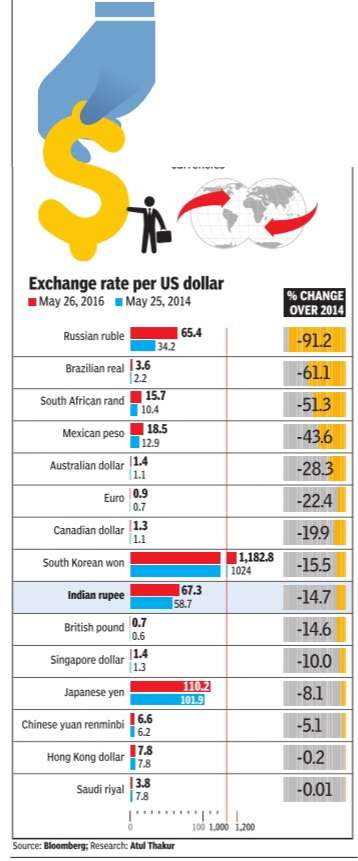
Mayur Shetty
The Indian rupee, despite weakening nearly 5% against the dollar, has emerged as one of the best performing currencies in 2015 as most others have fallen sharply against the dollar. However, early 2016 could end up being volatile for the domestic unit as the dollar surges ahead in the wake of the rate hike by the US Federal Reserve.
The rupee closed at 66.15 at the end of 2015 on Thursday -24 paise stronger than its previous close a day earlier. The dollar has gained Rs 2.79 during the calendar year. Against the greenback, the rupee swung nearly 10% from a high of 61.33 on January 28 to a low of 67.10 on December 14 -which was also a two-year low . But the currency has been strongest among emerging nations.
Among the BRICS nations, only China has been on a par with the rupee with the Chinese yuan weakening by 4.72%. Brazil, Russia and South Africa have depreciated by 49%, 31% and 33% respectively against the greenback. However, early 2016 could end up being volatile for the domestic unit as the dollar surges ahead in the wake of the rate hike by the US Federal Reserve.
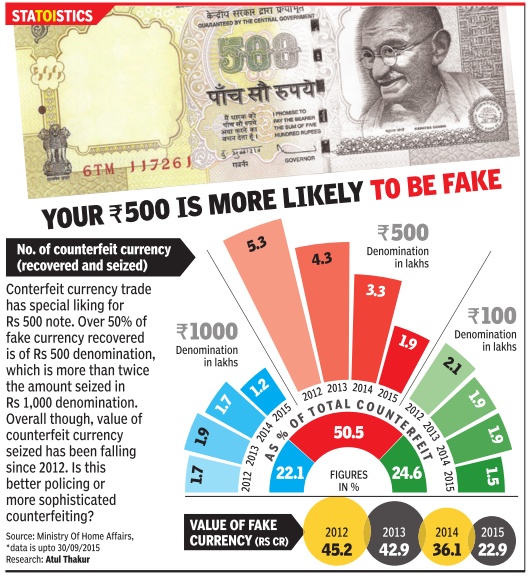
The rupee under various finance ministers
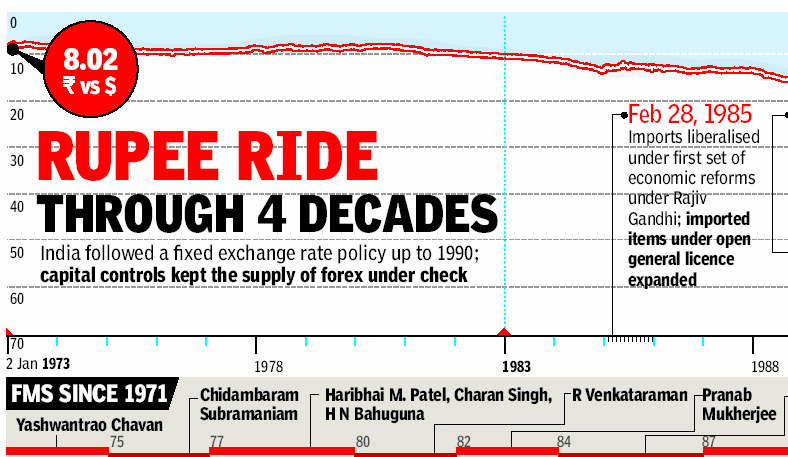
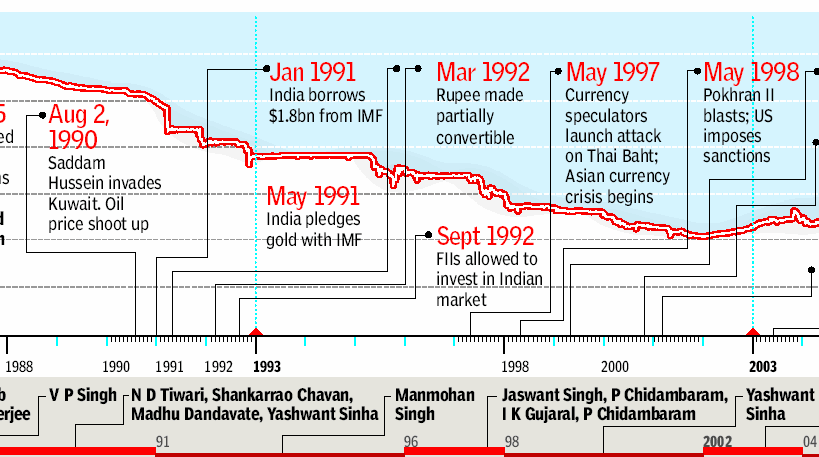
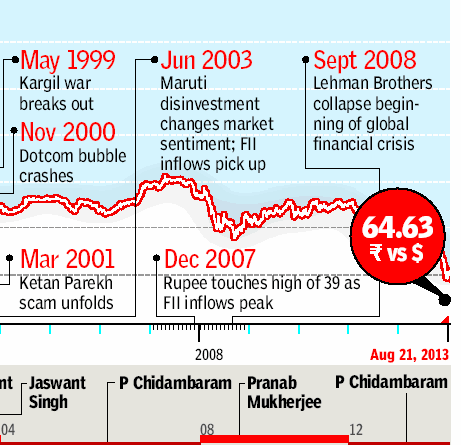
Counterfeiting currency
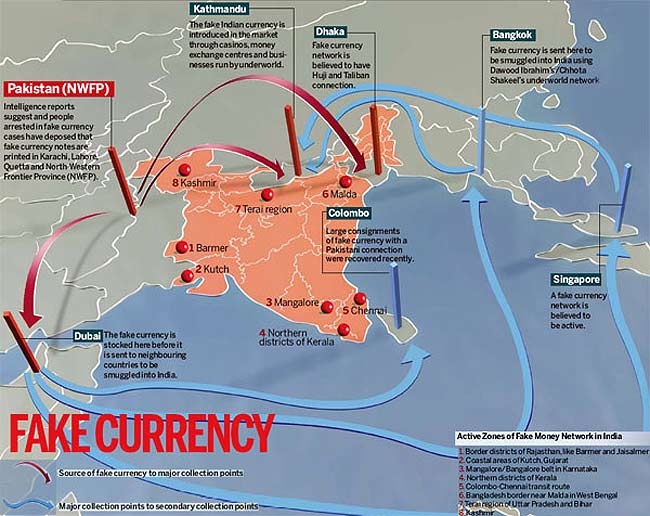
2012-15: Counterfeit currency
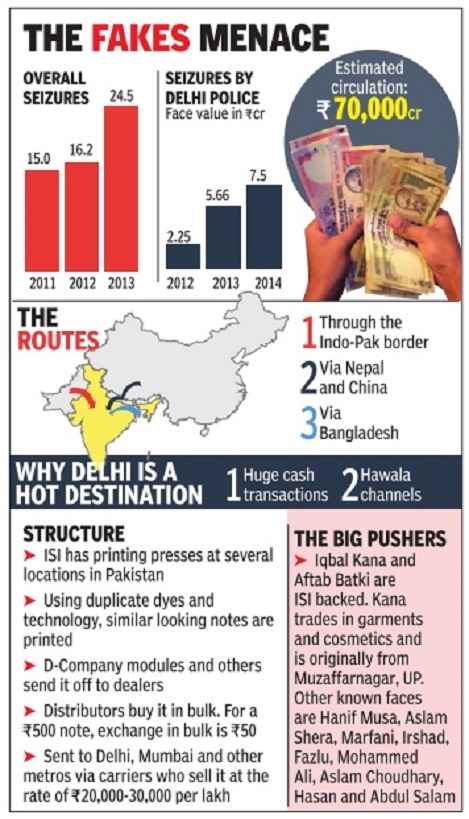
i) Seizures, and extent of counterfeit notes in circulation,
ii) The big pushers,
The Times of India
Mar 23 2015
In the past three years, fake currency worth Rs 125 crore has been seized and recovered by the government. According to the answer to a recent Rajya Sabha question, high-quality Indian currency notes printed in Pakistan are being smuggled into the country to create a self-sustaining terror network in south and southeast Asia. In Delhi alone, such currency worth Rs 40.4 crore (the highest in the country) was seized and recovered in the past three years. The national capital was followed by Maharashtra, Uttar Pradesh and Tamil Nadu, each registering recoveries of over Rs 10 crore.

The Times of India
2014: 3rd most counterfeited currency in Switzerland
In Switzerland: Most counterfeited currency after US Dollar and Euro
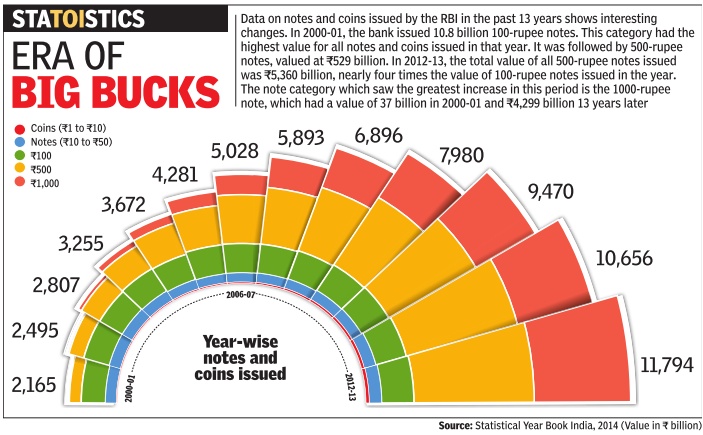
Rupee third on fake foreign currency list in Switzerland
The number of fake Indian rupee notes found in Switzerland during 2013 stood at 403 — the third highest for any foreign currency.
PTI | Jul 20, 2014
NEW DELHI/BERNE: As a debate continues on alleged black money of Indians in Swiss banks, the authorities in Switzerland have come across a significant quantum of fake Indian rupee notes in their country — the third highest for any foreign currency after Euro and the US dollar.
According to the latest counterfeit currency statistics released by Switzerland's Federal Office of Police (Fedpol), the number of fake Euro notes seized in the year 2013 stood at 2,394, while there were 1,101 fake US dollar bills.
The number of fake Indian rupee notes found in Switzerland during 2013 stood at 403 — the third highest for any foreign currency. This included 380 fake Rs 500 notes and another 23 counterfeit Rs 1,000 notes.
However, the numbers have declined considerably since 2012 when Fedpol found as many as 2,624 fake rupee notes — the second highest among foreign currencies after 5,284 counterfeit US dollar notes at that time. The number of fake Euro notes was third highest during that year at 2,084.
The number of fake Swiss franc notes stood at 4,309 during 2012, but was higher than any foreign currency in 2013 at 3,729, as per details compiled by the Fedpol's Counterfeit Currency Unit.
Among other counterfeit foreign currencies found during 2013, there were 99 fake British pound notes, 71 South African rand notes, 34 Deutsche Mark notes (German currency officially in circulation from 1948 till 2002 when Euro was introduced), 23 Chinese yuan notes and ten Canadian dollar.
The number of any other fake foreign currency notes was in single-digits.
Unaccounted for rupees in circulation
Millions of notes not printed in mints land in RBI vaults
Bank, Press Records Don’t Tally
Hemali Chhapia TNN
The Times of India 2013/08/04
Mumbai: Millions of currency notes worth hundreds of crores of rupees that have apparently never been printed at our nation’s mints have mysteriously made it to the vaults of the Reserve Bank of India over the years.
A series of RTI applications reveal that while the mismatch between currency bills printed and those transported to the RBI is seen across denominations, it is more pronounced in the case of higher value notes — those of Rs 1,000 and Rs 500.
Take the Rs 1,000 notes. The redesigned bill was introduced in October 2000. Ever since, the two authorized mints — Bharatiya Reserve Bank Note Mudran Private Limited, Bangalore, and Currency Note Press, Nashik — have printed a total of 4,452.3 million bills. But RBI records show that it has received 4,462 million notes, an excess of 9.7 million notes. That means the RBI has received Rs 970 crore more than what was actually printed.
WHAT THE RBI SPOKESPERSON SAYS
You have collected the data of printing from the press and the supply received from RBI. You cannot do that because there are a lot of logistics involved. Numbers must be compared from the one source; either you take RBI numbers or the printing presses’ numbers. You cannot mix and match.
An aggregate discrepancy of Rs 4,608 crore
In 2006-07 the number of 1000-rupee notes received by the RBI was 589 million. (The number of such notes printed that year was 591m.)
While this closes the difference between what was printed and what was received to a considerable extent, there still remains a discrepancy of about Rs 72 crore for the period in question, which the bank has attributed to “rounding off”.
However, there is a large discrepancy between the numbers provided by the Bharatiya Reserve Bank Note Mudran, RBI’s wholly owned subsidiary, in its response to two similar queries just a month and a half apart under the Right to Information Act. A response dated November 10, 2011 to a query indicates the total count of Rs 500 notes printed between 2000-01 and 2009-10 as 10,878m while another response dated December 24, 2011 shows 10,806 m notes were printed—a difference of 72.782m notes valued at over Rs 3,639 crore (see Tables 3a-c).
Similarly, there is a difference in the case of currency notes of Rs 1000 denomination. The November response indicates the total number of Rs 1000 notes printed between 2000-01 and 2009-2010 as 3094.69m while the December response places it at 3,085m—a difference of 9.69m notes valued at Rs 969 crore (see Tables 3a-c).
The aggregate discrepancy—Rs 500 and Rs 1,000 notes—between the two RTI responses is a significant Rs 4,608 crore.
2016: Fake notes with face value of Rs 400 crore in circulation
The Times of India, May 11 2016
Neeraj Chauhan 250 In Every 10 Lakh Bills Counterfeit: Indian Statistical Institute
Fake notes with face value of Rs 400 crore in circulation
As many as 250 of every 10 lakh notes in circulation in India are fake, and banknotes with a face value of Rs 400 crore are in circulation in the country at any given point of time. The first ever study of counterfeit money has unearthed that fake Indian currency notes (FICN) with a face value of Rs 70 crore are infused into the Indian market every year, with agencies only able to intercept one third of them.
These shocking revelations are part of the study on “Estimation of the quantum of FICN in circulation“, conducted by the Indian Statistical Institute (ISI) Kolkata, which has asked the government to take “immediate steps“, since these figures are only indicative of the extent of the menace.
The findings have been accepted by the government and a series of strong measures to counter this `economic terrorism' is being planned in consultation with the primary FICN detection and probe agency, National Investigation Agency, besides other security and intelligence agencies including CBI, IB, DRI, R&AW and sta te police departments.
The study has further revealed that the detection rate of fake 100 and 500 rupee notes were found to be about the same and higher than the detection rate of 1000 rupee notes by about 10%. It added that fake 1,000 rupee notes constitute about 50% of the total value of FICN.
The ISI study was based on volumes of FICN detected and cash transaction in the banking sector. The study said that “the detection of FICN is carried out primarily by commercial banks. However, their reporting is irregular too and only three banks Axis, HDFC and ICICI report about 80% of the detection“. ISI, however, concluded that “the existing systems of seizure and detection are enough to flush out the quantum of FICN being infused“. The institute says that if detection can be improved, the value of FICN in circulation can be reduced by at least 20% annually .
As per the NIA probe, which has a Terror Funding and Fake Currency Cell, Pakistan is the major supplier of FICN in India. “In 2015 alone, some 9-10 cases have come to the notice where FICN has come by sea or air from Pakistan,“ said NIA inspector general Alok Mittal. Link title
ATMs, banks dispensed 19L fake notes in less than 4 yrs
Arun Dev, ATMs, banks dispensed 19L fake notes in less than 4 yrs, Nov 28 2016 : The Times of India
Bengaluru:
Over the last three and a half years, 19 lakh counterfeit notes of different denominations worth Rs 14.97 crore were dispensed by ATMs and banks across the country, reveals an RBI report on `detection of fake Indian currency through bank channel'. The RBI doesn't attribute any real value to the notes, which continue to exchange hands, as they are not legal tender, and calls it notional.
A denomination-wise analysis shows that 5.42 lakh fake Rs 100 notes worth Rs 39.56 crore, 8.56 lakh Rs 500 notes worth Rs 42.8 crore and 4.7 lakh Rs 1,000 notes worth Rs 47 crore were dispensed through banking channels.
RBI guidelines mandate that banks should have currency checking machines to establish genuineness of notes. Before accepting deposits or loading cash into ATM machines, the currency must be checked using these machines.
2015: Safety measures
The Times of India, Jul 02 2015
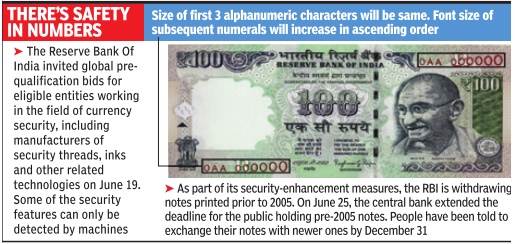

Partha Sinha
New feature on notes to give forgers run for money
To make Indian currency less prone to counterfeiting, the Reserve Bank Of India (RBI) has started printing Rs 100 notes on which the last six numerals of the nine-digit currency note number will be in ascending print size from left to right.
For example, if a Rs 100 note has the serial number 9AA 123456, the `9AA' part will have uniform print size.However, in the six-digit number portion, the print size for `2' will be larger than `1', print size for `3' will be larger than `2' and so on with `6' being in the largest font size. All other security features for this new series of Rs 100 notes will remain the same. The central bank will issue all currency notes, from Rs 10 to Rs 1,000 denomination, on which the num bering will be in this new ascending print size pattern, also called `exploding font'.“Printing the numerals in ascending size is a visible security feature in the banknotes so that the general public can easily distinguish a counterfeit note from a genuine one,“ a release from the central bank said. This new security fea ture is part of RBI's contin uing endeavour to improve security features of currency notes to make them more robust. Going forward, the currency notes will have moving images or variation in colour, micro-perfora tions etc. on security threads on each currency note.
RBI to mint 1.2cr coins for Kumbh devotees
The RBI is set to mint 1.2 crore coins of various denominations especially for the occasion. Bank officials estimate the total valuation of the coins at Rs 3 to Rs 3.5 crore.Anticipating a coin shortage, the State Bank of India (SBI) and the Bank of Maharashtra (BoM) have jointly ordered 1.2 crore coins of Rs 1, Rs 2 and Rs 5 denominations so that pilgrims can perform rituals as well as make offerings at Ramkund. “It is an age-old practice among Hindus to offer coins to sacred rivers such as the Godavari,“ said assistant general manager of SBI Sanjay Shrivastava. “Apart from offerings, pilgrims also give coins to beggars, which is considered auspicious,“ Shrivastava added.
Banknotes are guaranteed by the central government
The Times of India, Dec 23, 2016
Actually , it is both. The direct liability is on the RBI. The RBI Act, 1934, says the following: “The liabilities of the Issue Department (of RBI) shall be an amount equal to the total of the amount of the currency notes of the Government of India and bank notes for the time being in circulation.“ However, the same law also makes it clear that “every bank note shall be legal tender at any place in India... and shall be guaranteed by the Central Government.“ This is why banknotes are issued by the RBI and carry both a promise by its governor and the term “guaranteed by the central government“. The only exception is the one-rupee note which is issued by the government itself. In essence, the RBI acts as the government's currency manager.
Currency with the public
The Times of India, Apr 2, 2016
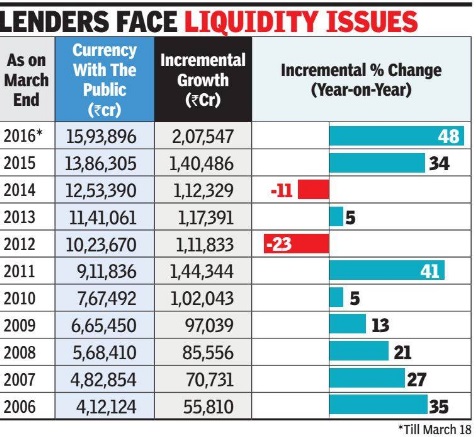
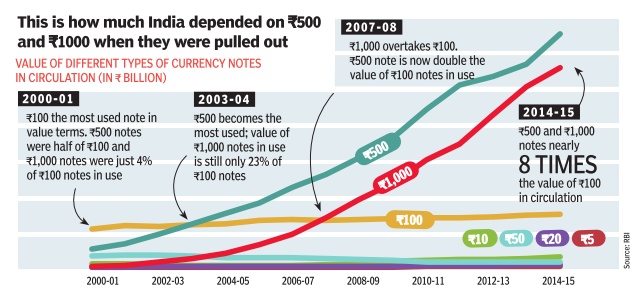
Mayur Shetty
A steep surge in the amount of currency in circulation has baffled bankers and economists as this preference for cash among the public is slowing down deposit growth and hurting banks. According to data released by the Reserve Bank of India, cash with the public grew by 48% in the last fiscal till March 18, adding over Rs 2 lakh crore to the currency in circulation. The unusual rise in cash with the public has prompted State Bank of India chairman Arundhati Bhattacharya to call upon the central bank to examine the reasons for the increase. Bhattacharya raised the issue amid banks facing issues of systemic liquidity due to high currencyholdings( bothintheform of cash and jewellery) as well as the rise in government cash balances with the RBI. According to SBI chief economist Soumya Kanti Ghosh, if people are withdrawing money to spend, it should reflect in higher economic activity, but numbers do not reflect this. "The manufacturing sector credit growth has completely collapsed to a little over 5%. The only sectors seeing growth are power and iron & steel, which is extremely distressing," he said.
High-value denomination notes have been going out of currency chests of banks to the hinterland, but not returning. This is despite a surge in card payments as well as a jump in bank accounts due to the Jan-Dhan Yojana. The last time when cash with the public grew at over 40% was in 2011. But that was in the midst of a fiscal stimulus and inflation was raging at 11%, prompting people to spend more.
According to Madan Sabnavis, chief economist, Care, gold demand has risen because of low interest rates, and since a large part of the transactions in the yellow metal takes place in cash, there has been an increase in currency with public. "Although inflation has come down, inflation expectation among public has not come down even as returns on deposits have declined. The reduction in small savings rate has made it easier for banks to bring down deposit rates. If you look at monetary policy as well as the recent action on small savings, they appear to be geared toward enhancing credit rather than encouraging savings," he said.
Another reason for the surge in cash as on March 18 could be a string of bank holidays that followed, according to Sujan Hajra, co-head, research at Anand Rathi Securities. But even if one were to look at currency growth as on February, the increase was as high as 38%. "With inflation low and with low return on most assets, the opportunity cost for holding cash and loss of opportunity due to moving to cash is low. The know-your-customer norms for investments in real estate has increased, which could be reducing the opportunity there. Most jewellers have also been on strike for long and they are one of the major sources for cash deposits into the banking system and this could also be a reason," said Hajra. Bank deposits continue to grow at a sluggish pace. As on March 18, 2016, the yearon-year growth in deposits stood at 9.9%.
Cash-to-GDP ratio
2012-13: 12%
Jan 19 2015
India's love for cash costs $3.5bn a yr
Cash-to-GDP ratio higher than peers, but e-payments double in 5 yrs: Study
The Reserve Bank of India and commercial banks annually spend around Rs 21,000 crore ($3.5 billion) in currency operations costs while citizens of Delhi alone spend Rs 9.1 crore and 60 lakh hours in collecting cash. The scale of this burden is unique to India considering that it is among the most cash-intensive economies in the world with a cash-to-GDP ratio of 12%, almost four times as much as other markets such as Brazil (3.93%), Mexico (5.3%) and South Africa (3.73%).
There are many reasons why India has to pay such a high price for its payments.One is the need to frequently reissue notes due to poor handling -low-value notes have to be replaced in less than a year. The other reason is the need to frequently upgrade security features and replace old notes. There is a huge cost in pulling old notes out of circulation and replacing them. India also has unique issues in logistics and in some places the cur rency notes have to be transported by helicopter.
A report on `Cost of Cash in India' commissioned by MasterCard and brought out by the Institute For Business In The Global Context has highlighted how much of a drag the overdependence on currency for payment is turning out to be. One reason for the increased dependence on cash is the lack of access to banking with a third of the population over 15 years not having used a bank account.
The report also highlights that although mobile banking has picked up, it is not yet being used for payments. There has been a jump in electronic payments since 2007 with its share increasing from 2.6% to 6.8%.This is largely due to the development of non-cash payment systems such as the Real Time Gross Settlement (RTGS), National Electronic Funds Transfer (NEFT) and National Electronic Clearing System (NECS). But the report says that growth in these segments has typically benefited the commercial sector more than retail clients. The value of transactions through ATMs has grown sixfold from Rs 3 lakh crore in 2007 to about Rs 18 lakh crore in 2012, according to the report. However, when the ATM transactions are weighted for population, India continues to fare poorly even when compared to lesser developed markets such as Kenya, Niger or Egypt. According to RBI data, in 2013, 15,400 crore banknotes were issued globally, of which the maximum banknotes, 5,400 crore, were issued by China and almost 2,000 crore by India. The glob al projections for the next three years have been worked out at 16,000 crore, 16,600 crore and 17,300 crore banknotes, for the world, China and India, respectively .
“The steps taken by RBI over the years strive to make the idea of financial inclusion a reality . Innovations in the electronic payments space not only deliver greater transparency but more importantly , they simplify transactions, enhance security , increase efficiency and have the potential to dramatically reduce costs,“ said Vikas Varma, area head, south Asia, MasterCard.
The report also busts the conventional wisdom which assumes that cash is free. Citing the example of Delhi, the report says that residents spend 60 lakh hours and Rs 9.1 crore ($1.5 million) to obtain cash. Compared to this, Hyderabad, which is smaller, spends 17 lakh hours and Rs 3.2 crore ($0.5 million) to do the same, which corresponds to fees and transport costs about twice as high as Delhi on a per capita basis.
Demonetisation of high value currency- 1946, 1978, 2016: India
See the detailed page Demonetisation of high value currency- 1946, 1978, 2016: India
Denominations in circulation
See graphic
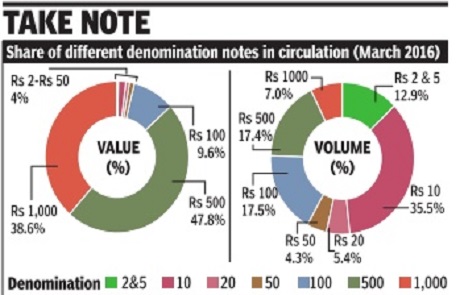
The Times of India
In March 2016
The decision to phase out Rs 500 and Rs 1,000 notes is linked to concerns over the increasing proportion of high-denomination currency in use.
Economic affairs secretary Shaktikanta Das said on Tuesday that, between 2011 and 2016, the circulation of all notes grew by 40%, but that of Rs 500 and Rs 1,000 notes grew by 76% and 109%, respectively . Between 2011 and 2016 the economy expanded by 30%, he added to emphasise the spurt in the Rs 500, Rs 1,000 bills' circulation.
In value terms, Rs 500 and Rs 1,000 notes accounted for 86.4% of the total value of bank notes in circulation, as of March 2016. Despite the emphasis and shift towards non-cash modes of transaction, the Indian economy remains flush with high value notes. In terms of volume, Rs 500 notes now account for 17.4%, and Rs 1,000 notes for 7% of the total notes in circulation.
July 2016: Exchange of pre-2005 notes stopped
The Times of India, Jul 01 2016
Banks will no longer exchange notes introduced prior to 2005. If anyone has such notes he would need to approach one of the 20 offices of the Reserve Bank of India directly to get such notes exchanged. However, there's a way out: If one has such notes, the person can deposit those notes in his bank account and the bank will send those notes to RBI.
Since January 2014, the RBI, through banks, has been withdrawing currency notes circulated prior to 2005. The central bank on Thursday said a large percentage of these notes have since been withdrawn, with only a small percentage still remaining in circulation. “On a review thereof, it has since been decided that July 1 onwards, the facility for members of public to exchange the pre-2005 notes will be available only at the following offices of RBI: Ahmedabad, Bengaluru, Belapur, Bhopal, Bhubaneswar, Chandigarh, Chennai, Guwahati, Hyderabad, Jaipur, Jammu, Kanpur, Kolkata, Lucknow, Mumbai, Nagpur, New Delhi, Patna, Thiruvananthapuram and Kochi,“ a release from the RBI said.
The RBI has also clarified that these pre-2005 banknotes will continue to remain legal tender, meaning people can use these notes just like other notes which were printed and circulated since 2005.
RBI sought Rs 5,000, Rs 10,000 notes
Under Rajan, RBI had sought Rs 5k, Rs 10k notes for `eroded' Rs 1k, Jan 21, 2017: The Times of India
The Reserve Bank of India (RBI), under former governor Raghuram Rajan, had suggested the introduction of Rs 5,000 and Rs 10,000 notes in view of the value of the Rs 1,000 note being eroded by inflation.
Information provided by the RBI to the Public Accounts Committee revealed that the central bank had made the recommendation in October 2014, some months after the Modi government took charge.
Some 18 months later, the government informed the RBI, in May 2016, about its “in principle“ decision to introduce a new series of Rs 2,000 notes, and the printing presses were finally given instructions in June last year.
This throws further light on the sequence of events and discussions between the RBI and the government ahead of the decision to demonetise the old Rs 500 and Rs 1,000 banknotes that was announced on November 8 last year.
Finance minister Arun Jaitley has said that the government did not accept the recommendation for Rs 5,000 and Rs 10,000 notes as it wanted replacement currency available immediately , and so went for Rs 2,000 notes. As it turned out, in the initial days following demonetisation, the acceptance of Rs 2,000 notes was low due to a lack of “change“, and higher denomination notes would have made the task even more problematic.
Printing, destroying, replacing Indian currency
How Indian banknotes are destroyed
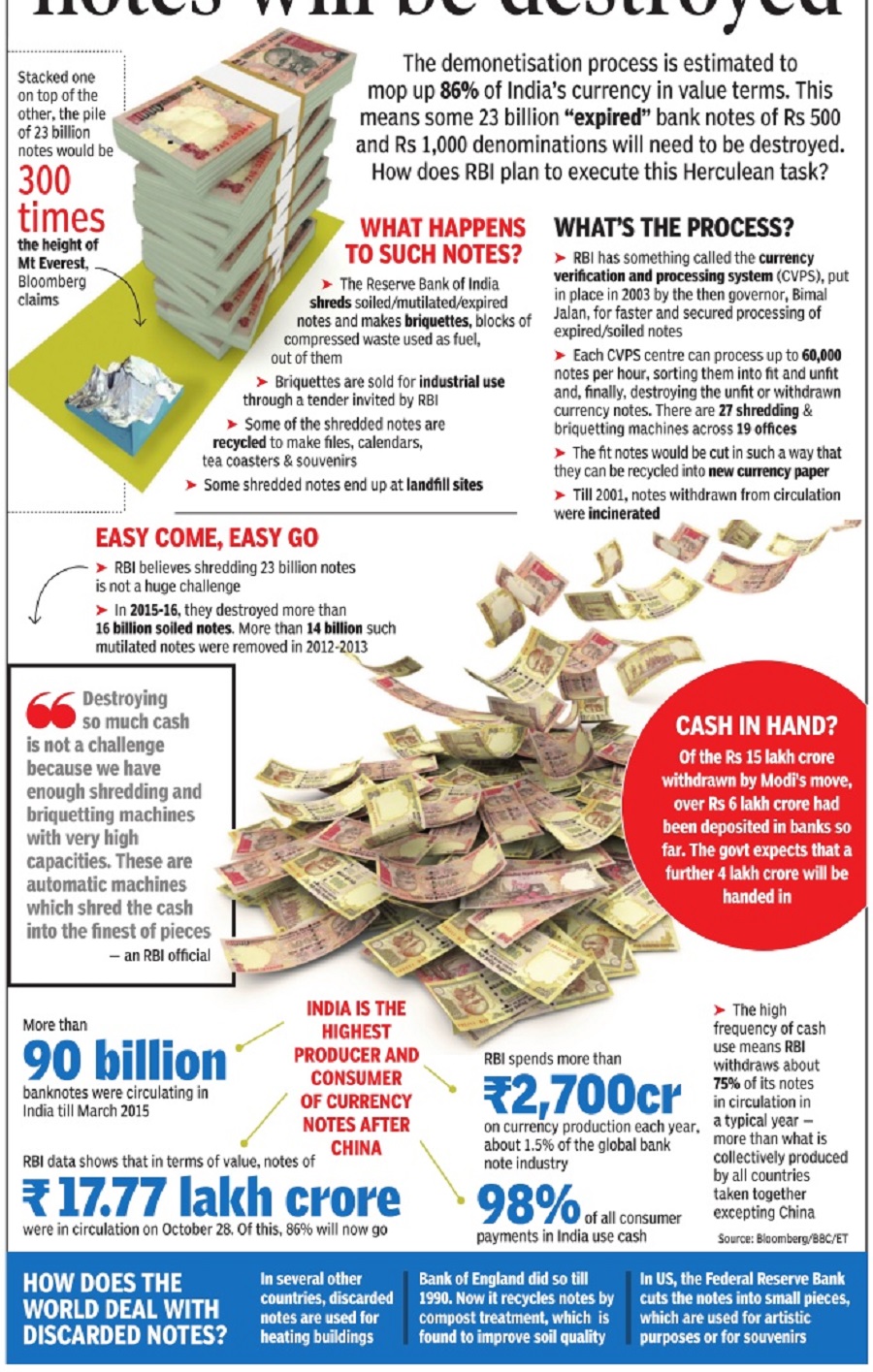
ii) Number and value of Indian banknotes in circulation in 2016
iii) Cost of production of currency to the RBI
The Times of India
See graphic.
Cost of printing: 2016
Sivakumar B, At 78p per print, Rs 1 note now profitable, Nov 06 2016 : The Times of India
Two different mints charge the Reserve Bank of India different amounts to print the same currency denominations. This was revealed in replies to an RTI plea filed by RTI activist Subhash Agarwal.
While Bharatiya Reserve Bank Note Mudran Pvt Ltd, an RBI-owned company , prints Rs 10 and Rs 20 notes at a cost of 70 and 95 paise, respectively , the same notes printed by the governmentowned Security Printing and Minting Corporation of India (SPMCIL) cost Rs 1.22 and Rs 1.216, respectively.
The cost of printing Re 1 notes at the SPMCIL has come down from Rs 1.14 per unit to 78.5 paise due to better use of technology . The printing of one-ru pee notes, which was discontinued in 1994 because of high printing cost, is now costing less, the RBI has revealed. The currency is printed by the SPMCIL.
The cost of printing Re 1 notes in 1994-95 was Rs 1.48 a note and when reintroduced, the cost came down to Rs 1.14 and now it has reduced below its nomination value to 78.5 paise.
Highest denominations of currency, India and the world
2017
See graphic
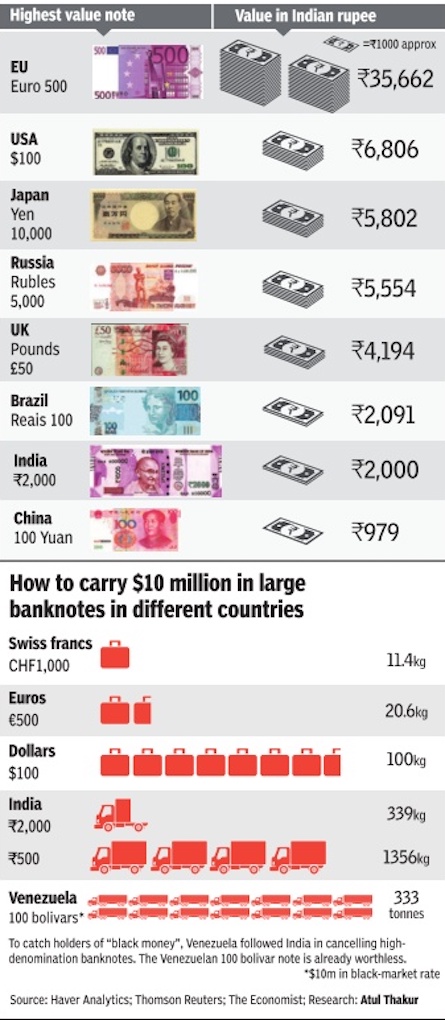
Rupee symbol
Rupee becomes only 5th currency to get a symbol Design By IIT Grad Cleared By Cabinet
New Delhi: In keeping with India’s growing economic might and its status as a major investment destination, the hitherto humble rupee is all set to get a distinct identity in the form of a new symbol. The Union Cabinet on Thursday gave its approval to the symbol which combines the Roman letter ‘R’ with the Devnagri ‘Ra’.
The symbol will catapult the rupee into the company of four ‘elite’ currencies which have similarly distinct identities — the US dollar, euro, yen and British pound.
The symbol has been designed by D Udaya Kumar, an IIT Bombay post-graduate, who has just joined as a teacher at IIT Guwahati. Kumar will receive a prize money of Rs 2.5 lakh for his efforts. The symbol will standardize the expression for the Indian rupee in different languages, both within and outside the country.
‘‘It’s a big statement on the Indian currency. It would distinguish the rupee from those countries whose currencies are also designated as rupee or rupiah, such as Pakistan, Nepal, Sri Lanka and Indonesia,’’ I&B minister Ambika Soni said after the Cabinet meeting. The symbol, she added, would reflect the strength and robustness of the Indian economy.
Till now, the Indian currency was simply denoted by Rs or INR. Kumar’s symbol was chosen after a public competition was held among resident Indian citizens inviting entries for a symbol which ‘‘reflects and captures the Indian ethos and culture’’.
Over 3,000 entries were received. These were evaluated by a jury headed by the RBI deputy governor, which included experts from reputed art and design institutes.
‘‘The entries were presented to the jury in such a manner that the identity of the competitors was not revealed to the jury members. The jury selected five final entries and also gave its evaluation of these five entries to the government to take a final decision,’’ said Soni. Re symbol to be adopted in 6 mths New Delhi: The new symbol for the rupee, cleared by Cabinet on Thursday, will not be printed or embossed on currency notes or coins, but it would be included in the ‘Unicode Standard’ and major scripts of the world to ensure that it is easily displayed and printed in the electronic and print media.
Unicode is an international standard that allows text data to be interchanged globally without conflict. After incorporation in the global and Indian codes, the symbol will be used by all individuals and entities within and outside the country.
The symbol will be adopted in a span of six months in the country, and within 18 to 24 months globally, Soni said, adding that it will feature on computer keyboards and software for worldwide use.
‘‘It is a perfect blend of Indian and Roman letters — capital ‘R’ and Devanagri ‘Ra’ which represents rupaiah — to appeal to international and Indian audiences. My design is based on the tricolour, with two lines at the top and white space in between,’’ Kumar told a news agency.
After encoding of the symbol in the Unicode Standard and National Standard, NASSCOM will approach software development companies for incorporating the rupee symbol in their operative software, as a new programme or as an update, to enable computer users worldwide to use the symbol even if it is not embedded on the keyboards (much like the way Euro symbol is used even though it is not embedded in the keyboards in use in India).
MAKING A MARK
The new symbol blends the Devnagri ‘Ra’ and Roman ‘R’. Its design is based on the tricolour, says creator D Udaya Kumar
Re. 1 notes
Dec 27 2014
One rupee notes are set to make a comeback after two decades, although in a different colour.
Instead of the familiar indigo, the new Re 1 notes will be predominantly pink-green on the front and back in combination with others, a finance ministry notification said.Unlike other currency notes, the Re 1 notes will be issued by the government. As was the norm earlier, the Re 1 note will be signed by the finance secretary, while the Reserve Bank of India governor will continue to sign notes of all other denominations.
“It contains the words `Bharat Sarkar' above the words `Government of India' with the year 2015 on the representation of the Re 1 coin with the rupee symbol having floral design and the surrounding design has a picture of `Sagar Samrat', the oil exploration platform and with the authentic rendering of value in fifteen Indian languages in the language panel with the year's figure on the centre bottom in international number,“ the notification said. Other currency notes have RBI printed on them.
Over the last few years, the government and the RBI have focused on coins for smaller denominations and discontinued Re 1 and Rs 2 notes citing the high cost involved and the clogging of presses. But the decision to go back to Re 1 notes came as a surprise.
Towards a cashless future
See graphic
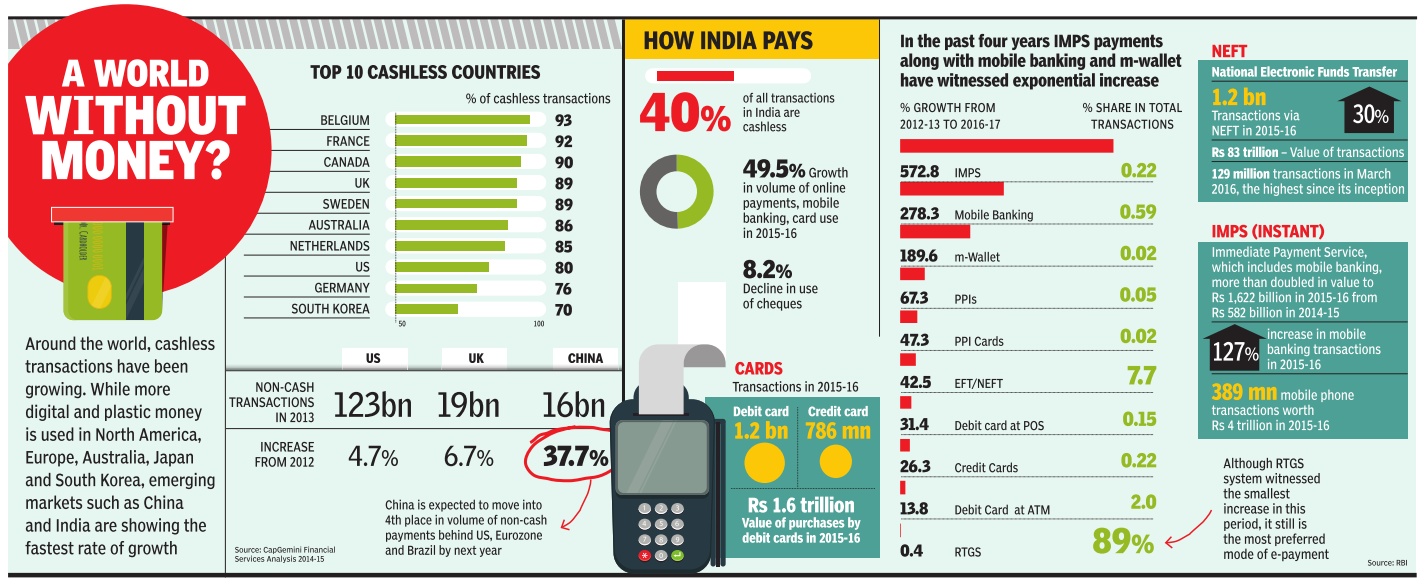
The Times of India
See also
Currency: India
Demonetisation of high value currency- 1946, 1978, 2016: India
Foreign currency inflows: India
Sensex <> The stock market: India <> Mutual Funds: India <> Gold in the Indian economy
